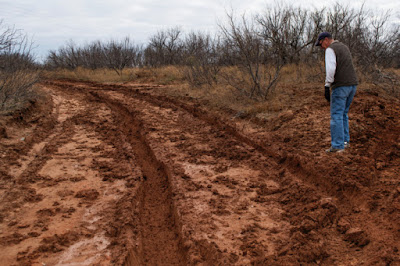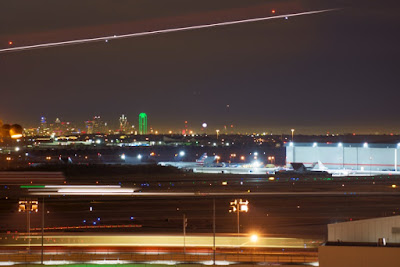Photographic and poetic meanderings along the countryside or while flying an airplane.
Except as noted, all images copyrighted by and should be attributed to E B Hawley.
I had become many eons ago a traveling literary gnome, inquisitive about places I had and had not visited,
walking the same paths of peoples from the past, through places once grand and still grand,
photographing images that now show me the places about which I still dream . . .
Monday, January 18, 2016
Sunday, January 10, 2016
Clara Cemetery Gate
Clara, Texas, began as a community in 1886 on the corner of FM1813 and SH240.
For more information, visit the Wichita County Historical Commission's web site.
Saturday, January 9, 2016
Friday, January 8, 2016
Burkburnett's Historical Fuel Station
Stumbling upon Russell Miller, Director of Burkburnett's Historical Society, I was invited to view their new static display of one of the Panhandle Oil stations. Their office is in the old depot building, and for years there sat next to it (a fortuitous happenstance) an abandoned fuel station, trashy and messy. Mr. Miller, upon retiring from his profession in the school system, began work in restoring the old station.
The Burkburnett Historical Society owns the three buildings shown above. Pump is at right.
(Photo taken during a very foggy morning, and so, for effect, I borrowed the background sky from another image.)
With the assistance of generous supporters, such as Cheney Electric Company, Sean Lam, Roberta Martin (who donated the tall fuel pump), C. C. Corbin, Robert Gill, and Mike Klipp, the Burkburnett Historical Society and Mr. Martin were able to restore the old fuel station that served the community during the early 1900s. (Background sky is borrowed from another image.)
Placing my camera against the glass, I captured a part of the exhibit that shows a desk and other accoutrements, including a domino board. They placed a spittoon alongside the chair.
Peering through the glass on the door, one can see inside the station.
Sign above the door of the station.
Visit Burkburnett Historical Society's Facebook page.
Wednesday, January 6, 2016
Muddy Search for a Memorial: ClayCo No. 1
On a cloudy Saturday afternoon, a couple of days after a few storms blew through the area, and on a year that broke the record for rain, MyMrMallory and I decided to traipse over to Electra, Texas, to view a stone memorial. We had no idea that this one marker differed from the others around the county in that it stands in an active oil field.
The memorial to the first significant oil well drilled in Wichita County sits in an active oil field.
Installed in 1946, the marker is a metal plate bolted onto a granite stone. It sits on a gravel foundation surrounded by a metal barrier.
The marker says, "ClayCo No. 1. Here flowed oil, April 1st, 1911 opening one of the world's greatest oil fields." By the end of that year, Electra reported 900,000 barrels of oil had been produced.
Photograph of ClayCo No. 1 from the American Oil & Gas Historical Association.
Read their interesting story about Electra, Pump Jack Capital of Texas.
We had no idea that the oil field had become soggy and muddy, why, not at all. None of the overflowing ponds along the roads, the water standing ankle-deep in the ditches, none of that gave us any clue that we would encounter any mud at all in the countryside.
From Electra, crossing Highway 287, we headed north State Highway 25 for less than a quarter of a mile. On both sides of the road, we passed two cemeteries. Google Earth identified them as the Old Electra Memorial Cemetery on the west side of the road, and the New Electra Cemetery on the east side. Next to the Old Electra Memorial Cemetery on the west side, we came upon the Precinct #4 Annex, and next to it we found the gate to the oil patch in which the marker, somewhere, has sat since May 2nd, 1946.
Our eyes wide open, we searched for the landmarks that Mary Kearby, from the Wichita County Historical Commission, had written in her instructions fifteen years ago, aware that things change within the period of fifteen years.
At the gate, a centennial celebration sign gave us some comfort. The sign showed a picture of an oil well with the name ClayCo #1 written in large, clear letters.
Mary's directions mentioned the Belco Energy Company, apparently no longer there, for there were no obvious signs. The operating company for the oil field wells is now the Layline Energy Company.
The Precinct #4 Annex does still exist, helping us to find the gate, which stands next to it. Finding it open, we crossed the cattle guard, and that is when we note the condition of the roads in the field. One of them leads to the stone memorial, yes, the worst one, the one with the most water puddled and the one with the deepest ruts.
I felt ready to go home and snuggle up in our nice cozy home, hot cocoa, little fire going in the fireplace. MyMrMallory, though, hopped out of the truck and began to walk across the pasture. I pulled on my boots and started after him.
Cattle ran away from us as we walk toward the muddy roads.
Deep ruts on a muddy road.
Oh, a pumper appeared! So unexpected on a Saturday afternoon. We felt lucky, for now we can save time by asking him the location of the marker. He is fearless driving his truck on those muddy roads.
Mr. Stacy Case, stopped to give us instructions and to visit for a while about his life in the oil field.
A "turtle head," perhaps one hundred years old, was employed to repair rods.
Mr. Stacy directed us to walk to the left of the abandoned power house.
The road to the marker is the second right after the power house.
The delineation of the Mobile Flying Filly on the front wall of the power house.
A rolled up belt among the mesquite that surrounds the power house.
The holes through which the belts moved in and out of the power house. Powerhouses protected the engines that ran the pumping units in the surrounding field. Later at home, MyMrMallory found a post about an old powerhouse at the USDA site. Specifically, that it had a "rhythmic thumping" and a "clinking of rod lines," and "screeching of belts [ . . .] now just echoes in the wind, ringing off the scrap metal walls." Reading the description of what it might have sounded placed us in that time when roughnecks kept in functioning order the engine in the powerhouse.
Mr. Stacy's blue rag helped us to find the location of the memorial.
A map he drew for us is of great help, too.
In 1915 and again in 1919, the area received records amounts of rain, as we did this year.
Just image the pumpers slogging through the mud back then, too, perhaps in a Wichita truck. Visit the Texas Transportation Museum's Web site to view images of trucks from that era.
Sunday, January 3, 2016
Thursday, December 31, 2015
Wednesday, December 30, 2015
Cattle and Horses at the Barn
In the mornings, cattle and horses emerge from the pastures, have a bite to eat, sip some tea or coffee, chat about the day's plans, then lumber back into the pastures.
Sunday, December 27, 2015
Red Peninsula on Lake Kickapoo
On a rainy, misty day, soon to turn snowy, I noted the clay-colored water and the red grass on the shore of Lake Kickapoo contrasting with the grays of the rest of the landscape.
Saturday, December 26, 2015
Thursday, December 24, 2015
Sneaking Up on Sandhill Cranes
On a desperately windy day, the Sandhill Cranes could neither see me or hear me as I, in my characteristic finesse, stomped my way across the wheat field toward them. Hiding myself behind the bern of a pond, I crawled toward the cranes. I could hear their delightful banter, that low guttural sound that one hears and recognizes right away, even from miles away.
From my position behind the bern, I watched the flock of about one thousand through dormant sunflower and other plants. They chatted, ate, and danced.
Then, one of them became quite suspicious.
A couple of them decided to fly over me, the interloper whose hat and lens peer over the bern.
They sounded the alarm.
Wednesday, December 23, 2015
Crawfish Chimney
Interesting information, fun to read, too, about crawfish and their mounds at the America's Wetlands Foundation website.
Crawfish chimney.
Wallace Pond.
I borrowed the background with the clouds from another image, and merged the two together. Pollution in the background image looked so odd, that I decided to convert to black and white.
Wednesday, December 16, 2015
Subscribe to:
Posts (Atom)
Let Lovely Turn of Phrase Begin
JMHawley Gave Me a Kiss to Build a Dream On
Listen, will you? I think that . . . literature, poetry, music and love make the world go round . . . while mathematics explains things; I fill my life with them, then go walking in snowy woods.
Let us go then, you and I
like two etherized patients floating
through life, together feeling prufrockian.
DDB Jr. makes my world go 'round; during his absence, Pachelbel fills it up.
One summer I sailed across the Atlantic Ocean, then through the Gulf of Finland to reach Saint Petersburg; I pursued Joseph Brodsky in its alley ways. I dream of making that two summers.
I read “Biking to Electra;” found my way in a Jaguar car, and glanced at the flashing steel grasshoppers at sunset. I’ll follow K.O.P.’s footsteps after he followed N.Scott Momaday’s; find warmth and inspiration on a rainy mountain.
Throw chinese coins for the I Ching.
Save the whales, the spotted owl, the woman in toil.
Cast a fly for trout; my memories of fly fishing under the sunny blue Colorado sky remain; I yearn to build more . . . with more trophy Browns.
Listen for the swan’s calls on the Baltic Sea. Feel KKII's joy, his arms spread wide in Yazilikaya.
Good night, Jimmy Durante, where ever you are.
Listen, will you? I think that . . . literature, poetry, music and love make the world go round . . . while mathematics explains things; I fill my life with them, then go walking in snowy woods.
Let us go then, you and I
like two etherized patients floating
through life, together feeling prufrockian.
DDB Jr. makes my world go 'round; during his absence, Pachelbel fills it up.
One summer I sailed across the Atlantic Ocean, then through the Gulf of Finland to reach Saint Petersburg; I pursued Joseph Brodsky in its alley ways. I dream of making that two summers.
I read “Biking to Electra;” found my way in a Jaguar car, and glanced at the flashing steel grasshoppers at sunset. I’ll follow K.O.P.’s footsteps after he followed N.Scott Momaday’s; find warmth and inspiration on a rainy mountain.
Throw chinese coins for the I Ching.
Save the whales, the spotted owl, the woman in toil.
Cast a fly for trout; my memories of fly fishing under the sunny blue Colorado sky remain; I yearn to build more . . . with more trophy Browns.
Listen for the swan’s calls on the Baltic Sea. Feel KKII's joy, his arms spread wide in Yazilikaya.
Good night, Jimmy Durante, where ever you are.

















































